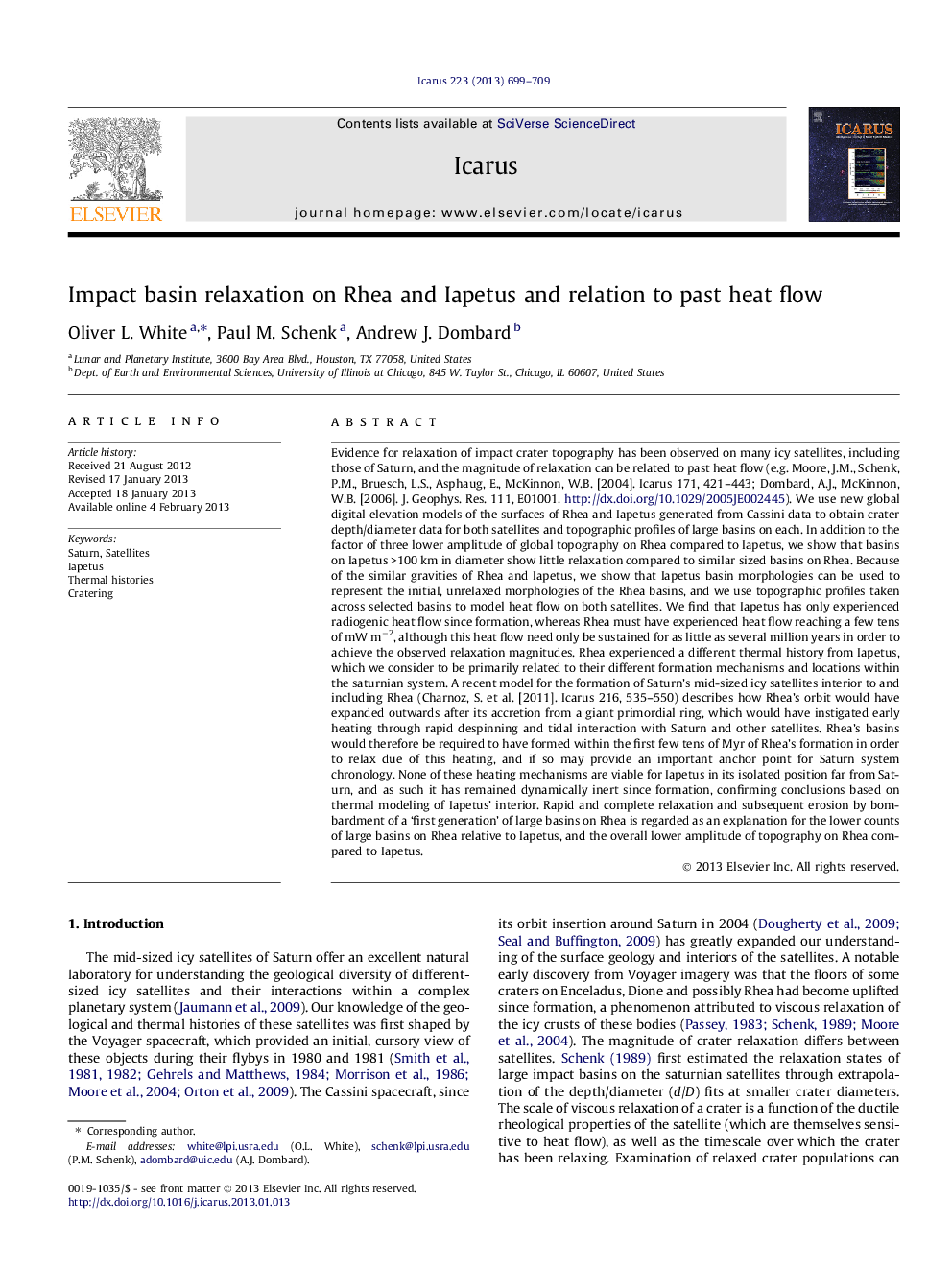| کد مقاله | کد نشریه | سال انتشار | مقاله انگلیسی | نسخه تمام متن |
|---|---|---|---|---|
| 1773349 | 1021127 | 2013 | 11 صفحه PDF | دانلود رایگان |

Evidence for relaxation of impact crater topography has been observed on many icy satellites, including those of Saturn, and the magnitude of relaxation can be related to past heat flow (e.g. Moore, J.M., Schenk, P.M., Bruesch, L.S., Asphaug, E., McKinnon, W.B. [2004]. Icarus 171, 421–443; Dombard, A.J., McKinnon, W.B. [2006]. J. Geophys. Res. 111, E01001. http://dx.doi.org/10.1029/2005JE002445). We use new global digital elevation models of the surfaces of Rhea and Iapetus generated from Cassini data to obtain crater depth/diameter data for both satellites and topographic profiles of large basins on each. In addition to the factor of three lower amplitude of global topography on Rhea compared to Iapetus, we show that basins on Iapetus >100 km in diameter show little relaxation compared to similar sized basins on Rhea. Because of the similar gravities of Rhea and Iapetus, we show that Iapetus basin morphologies can be used to represent the initial, unrelaxed morphologies of the Rhea basins, and we use topographic profiles taken across selected basins to model heat flow on both satellites. We find that Iapetus has only experienced radiogenic heat flow since formation, whereas Rhea must have experienced heat flow reaching a few tens of mW m−2, although this heat flow need only be sustained for as little as several million years in order to achieve the observed relaxation magnitudes. Rhea experienced a different thermal history from Iapetus, which we consider to be primarily related to their different formation mechanisms and locations within the saturnian system. A recent model for the formation of Saturn’s mid-sized icy satellites interior to and including Rhea (Charnoz, S. et al. [2011]. Icarus 216, 535–550) describes how Rhea’s orbit would have expanded outwards after its accretion from a giant primordial ring, which would have instigated early heating through rapid despinning and tidal interaction with Saturn and other satellites. Rhea’s basins would therefore be required to have formed within the first few tens of Myr of Rhea’s formation in order to relax due of this heating, and if so may provide an important anchor point for Saturn system chronology. None of these heating mechanisms are viable for Iapetus in its isolated position far from Saturn, and as such it has remained dynamically inert since formation, confirming conclusions based on thermal modeling of Iapetus’ interior. Rapid and complete relaxation and subsequent erosion by bombardment of a ‘first generation’ of large basins on Rhea is regarded as an explanation for the lower counts of large basins on Rhea relative to Iapetus, and the overall lower amplitude of topography on Rhea compared to Iapetus.
• Impact basins >100 in diameter are unrelaxed on Iapetus, but are relaxed on Rhea.
• Iapetus has only experienced radiogenic heat flow since formation.
• Rhea has experienced an elevated heat flow of tens of mW m−2 since formation.
• Rapid despinning and tidal resonances may have caused Rhea’s elevated heat flow.
• Rhea may have displayed a first generation of large basins that are now erased.
Journal: Icarus - Volume 223, Issue 2, April 2013, Pages 699–709